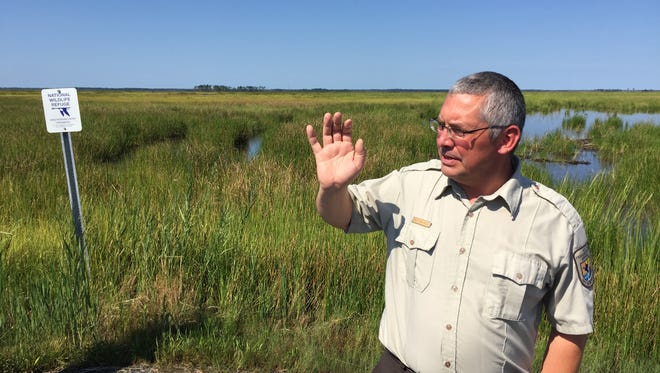Sea level is rising. Delmarva refuge's solution? Build taller marshes

There's an old country song whose chorus goes, "Give me 40 acres, and I'll turn this rig around."
It's unclear whether that Red Simpson ditty is popular inside the headquarters at the Blackwater National Wildlife Refuge. But trade the word "rig" for "marsh," and that's exactly what federal officials and conservation groups are doing to combat the twin threats of rising seas and sinking land there.
They hope that the $2.1 million marsh restoration project, which at 40 acres is the largest of its kind ever attempted in the Chesapeake Bay region, provides a road map for similar efforts elsewhere around the estuary.
"We literally have life that would be gone," U.S. Sen. Ben Cardin of Maryland said Sunday as he toured the recently completed project. "We can't stop sea level from rising, but we can adapt to the consequences."

Late last year, workers dredged 26,000 cubic yards of inky mud from the bottom of the Blackwater River and piled it up on a largely submerged marsh. Returning the following spring, they plugged about 220,000 sprigs of cord grass and other water-loving natives into the newly formed earth.
With the benefit of a summer's growing season, a deep green pasture of marsh now stands where there had been open water a year earlier, officials say.
That grass is perched on land that is up to nearly 8 inches higher than it was before. That should extend its life by "several decades" beyond what is currently forecast for other, untouched marshes inside the nearly 30,000-acre refuge, they say.
"You're maximizing the ability of these plant communities to respond to future sea level rise," said Matt Whitbeck, a wildlife biologist at the refuge.
READ MORE:Partnership working to save wetlands
The Blackwater refuge in southern Dorchester County is a poster child for climate change — literally. A kiosk near one of the refuge's boardwalks displays shows successive aerial images taken in 1938, 1974 and 1989. In each of the latter two, there is significantly less marsh and more open water.

More than 5,000 acres of wetlands have disappeared within the refuge's boundaries since its founding in 1933, according to the U.S. Fish and Wildlife Service, Blackwater's operator. An average of 300 acres are drowned each year.
The causes are diverse.
Global warming is causing seas in the region to rise at a rate of about a tenth of an inch each year, and the land is sinking at about the same rate. For decades, the marsh faced a foe much closer to home: an invasive, orange-toothed rodent called nutria.
A vestige of the fur trade, the nutria have been effectively wiped out from the refuge and the surrounding Delmarva Peninsula, but officials maintain a close watch to ensure they don't return.
"We can't wait to have the eradication party," said Margaret "Marnie" Pepper, who oversees Fish and Wildlife's nutria efforts in the Chesapeake region.

Cardin was joined by several other elected officials for Sunday's tour, including Maryland Sen. Addie Eckhardt as well as state Delegates Johnny Mautz and Chris Adams.
The restored area lies about a 10-minute drive away from the refuge's visitor center down Maple Dam Road, just south of a bridge over the Blackwater River. The drive itself provided a stark preview of the coming changes tied to climate change as cars were forced to slow to a crawl through stretches of floodwater.
No, it hadn't rained. It was a sunny, low-humidity day. The water had risen because of an unusually high tide, triggered by the presence of a new moon, Whitbeck explained.
READ MORE:Idea for Tangier Island sea wall funding gets support from local officials
Marsh restoration has been done with some success in other parts of the country and inside the refuge itself, Whitbeck said. What makes the recent Blackwater project unique, he said, is its use of groundbreaking research to determine how the marsh should be constructed.
Most projects rely on the height of a nearby marsh to guide their dredge work. In this case, engineers employed the findings of a 2012 study that pegged the ideal height for marsh development at 30 centimeters, or about 11.8 inches, above sea level, he said.
Funding for the project came from Superstorm Sandy relief money, awarded through a National Fish and Wildlife Foundation grant program.

Conservation groups praised the project, saying it should provide protection to nearby communities during future storms and serve as habitat for birds, such as the endangered black rail.
"The response of native marsh grasses has been exciting to see," said Erik Meyers, the project's director at The Conservation Fund. "We are seeing vigorous growth across the entire treated area."
410-845-4630
On Twitter @Jeremy_Cox